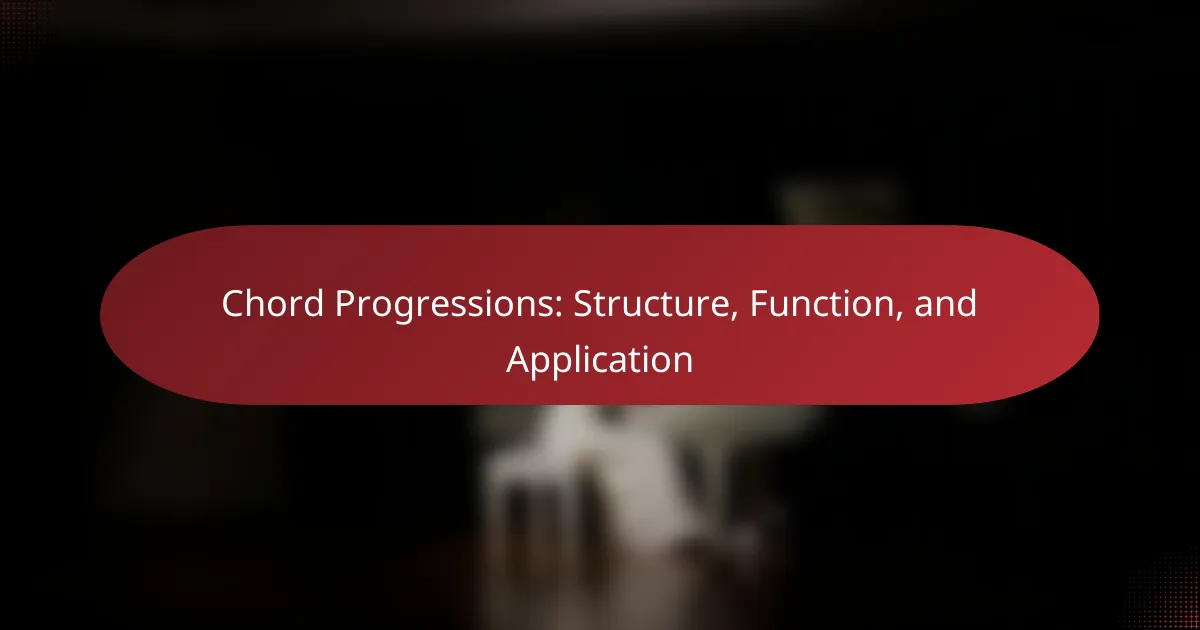Music theory serves as a crucial foundation for electronic music production, enabling artists to develop harmonies, melodies, and rhythms that captivate audiences. By mastering key elements such as harmony, melody, and rhythm, producers can create structured compositions that are both innovative and technically proficient. Techniques like improvisation, sound layering, and sampling further enhance creativity, allowing musicians to explore new sonic landscapes and refine their artistic expression.

How is music theory applied in electronic music production?
Music theory is fundamental in electronic music production, guiding the creation of harmonies, melodies, and rhythms. Understanding these principles allows producers to craft tracks that are both engaging and technically sound.
Chord progressions in electronic tracks
Chord progressions form the backbone of many electronic tracks, providing emotional context and structure. Common progressions like I-IV-V or ii-V-I are frequently used, but experimenting with variations can yield unique results.
Producers often use software to visualize and manipulate chord progressions, allowing for quick adjustments. A good rule of thumb is to keep progressions simple, especially in genres like house or techno, where repetitive structures can enhance the groove.
Melody creation techniques
Creating melodies in electronic music often involves layering sounds and using different synths to achieve a rich texture. Techniques such as arpeggiation, where notes of a chord are played in sequence, can add movement and interest to a track.
Producers should consider using a combination of short, catchy phrases and longer, evolving lines to maintain listener engagement. Utilizing MIDI controllers can facilitate real-time experimentation, allowing for spontaneous melodic ideas to emerge.
Rhythm and timing strategies
Rhythm is crucial in electronic music, as it drives the energy of a track. Producers often use a steady four-on-the-floor kick drum pattern, but incorporating syncopation and off-beat elements can create a more dynamic feel.
Experimenting with different time signatures and swing settings can also add complexity to the rhythm. A practical tip is to layer percussion sounds to create a fuller rhythmic palette, ensuring that each element complements the others.
Use of scales and modes
Understanding scales and modes is essential for crafting melodies and harmonies that resonate emotionally. While major and minor scales are common, exploring modes like Dorian or Mixolydian can introduce fresh tonalities to a track.
Producers should experiment with different scales to evoke specific moods; for instance, the Phrygian scale can create a darker atmosphere. A good practice is to sketch out melodies using a chosen scale to see how it influences the overall sound.
Sound design principles
Sound design is a key aspect of electronic music, involving the creation and manipulation of sounds to fit the desired aesthetic. Producers should focus on layering sounds, using effects like reverb and delay to create depth and space.
Utilizing synthesis techniques such as subtractive or additive synthesis can lead to unique sound textures. A common approach is to start with a basic waveform and gradually shape it using filters and modulation to achieve the desired character.

What techniques enhance creativity in electronic music?
Techniques that enhance creativity in electronic music include improvisation, sound layering, sampling, and automation. These methods allow producers to explore new ideas, create unique textures, and streamline their workflow.
Improvisation methods
Improvisation in electronic music involves spontaneous creation, often using MIDI controllers or synthesizers. This technique encourages experimentation and can lead to unexpected musical ideas. For instance, using a loop pedal allows artists to layer sounds in real-time, fostering a dynamic creative process.
To effectively improvise, set a time limit for each session and focus on a specific theme or mood. This constraint can help generate fresh ideas while keeping the workflow efficient.
Layering sounds for depth
Layering sounds involves combining multiple audio tracks to create a fuller, richer sound. This technique can enhance the emotional impact of a piece and add complexity to the arrangement. For example, layering a bass synth with a kick drum can provide a solid foundation for a track.
When layering, consider using different sound textures and frequencies to avoid muddiness. Aim for a balance between harmony and contrast, ensuring that each layer contributes to the overall sound without overwhelming it.
Sampling and remixing
Sampling and remixing are key techniques in electronic music that involve taking snippets from existing tracks and recontextualizing them. This can breathe new life into old material and inspire creativity. For instance, using a vocal sample from a classic song can add nostalgia while creating something entirely new.
When sampling, be mindful of copyright laws and seek permission when necessary. Additionally, consider the tempo and key of the original sample to ensure it fits seamlessly into your composition.
Automation in production
Automation in electronic music production refers to the process of programming changes in parameters over time, such as volume, panning, or effects. This technique allows for dynamic shifts within a track, enhancing its expressiveness. For example, automating a filter cutoff can create tension and release during a build-up.
To effectively use automation, plan out your track’s structure and identify key moments where changes will have the most impact. Avoid over-automation, as it can lead to a cluttered mix; instead, focus on subtle adjustments that enhance the overall flow.

What are the key elements of music theory for electronic musicians?
The key elements of music theory for electronic musicians include harmony, melody, rhythm, meter, dynamics, and expression. Understanding these components allows artists to create compelling and structured compositions that resonate with listeners.
Understanding harmony and melody
Harmony and melody are foundational elements in music theory that shape the emotional and aesthetic qualities of a track. Harmony involves the combination of different musical notes played simultaneously, while melody refers to a sequence of notes that are perceived as a single entity. Electronic musicians often use synthesizers and software to create rich harmonic textures and memorable melodic lines.
To effectively utilize harmony, consider using chord progressions that evoke specific feelings. Common progressions, such as the I-IV-V or ii-V-I, can serve as a solid base for your compositions. Experimenting with different voicings and inversions can also enhance the harmonic depth of your music.
Importance of rhythm and meter
Rhythm and meter are crucial for establishing the groove and flow of electronic music. Rhythm refers to the timing of notes and sounds, while meter provides the underlying structure that organizes these rhythms into patterns. A strong rhythmic foundation can make a track more engaging and danceable.
When creating beats, consider using a variety of rhythmic patterns, such as syncopation or polyrhythms, to add interest. Additionally, maintaining a consistent tempo, typically between 120 and 130 BPM for dance music, can help ensure that your track is suitable for clubs and festivals.
Application of dynamics and expression
Dynamics and expression play a significant role in conveying emotion and energy in electronic music. Dynamics refer to the variations in loudness throughout a piece, while expression encompasses the nuances that give a performance its character. Together, they can transform a static track into an engaging listening experience.
To effectively apply dynamics, consider using automation to adjust volume levels, filter sweeps, and effects over time. This can create tension and release, keeping listeners captivated. Additionally, incorporating expressive elements such as swing or humanization can make your electronic compositions feel more organic and less mechanical.

How do famous electronic artists utilize music theory?
Famous electronic artists leverage music theory to create compelling compositions that resonate with audiences. They apply concepts such as harmony, melody, and rhythm to craft unique soundscapes that define their signature styles.
Deadmau5’s chord structures
Deadmau5 is known for his intricate chord progressions that often feature extended chords and voicings. He frequently employs seventh and ninth chords to add depth and emotion to his tracks, creating a lush harmonic backdrop. For example, in tracks like “Strobe,” he uses these structures to build tension and release, enhancing the overall listening experience.
When creating chord progressions, consider using a combination of major and minor chords to evoke different moods. Experiment with inversions to create smoother transitions between chords, which can make your music feel more cohesive.
Calvin Harris’ melodic hooks
Calvin Harris excels at crafting catchy melodic hooks that are easy to remember and sing along to. His use of simple, repetitive melodies often makes his tracks highly accessible and radio-friendly. For instance, songs like “Summer” feature straightforward melodic lines that stick in listeners’ minds, driving engagement and popularity.
To create effective melodic hooks, focus on using a limited range of notes and repetitive phrasing. This approach can help your melodies become more memorable. Additionally, consider layering harmonies to enrich the sound without complicating the core melody.
Daft Punk’s rhythmic innovations
Daft Punk is celebrated for their innovative use of rhythm, blending elements from various genres to create unique grooves. They often incorporate syncopation and polyrhythms, which add complexity and drive to their music. Tracks like “Get Lucky” showcase their ability to fuse disco rhythms with electronic elements, resulting in infectious dance tracks.
When experimenting with rhythm, try layering different rhythmic patterns to create a more dynamic feel. Utilize swing and shuffle techniques to add groove, and don’t shy away from using off-beat accents to keep listeners engaged. Remember that a strong rhythmic foundation can elevate your electronic compositions significantly.

What are the prerequisites for learning music theory in electronic music?
To effectively learn music theory in electronic music, a basic understanding of music notation and familiarity with digital audio workstations (DAWs) are essential. These skills provide a foundation for composing, arranging, and producing music in a digital environment.
Basic music notation knowledge
Understanding basic music notation is crucial for anyone looking to delve into music theory for electronic music. This includes recognizing notes, rhythms, scales, and key signatures, which are fundamental for reading and writing music. Familiarity with these elements allows for better communication with other musicians and enhances your ability to create complex compositions.
Start by learning the staff, note values, and common time signatures. Resources like online tutorials or music theory apps can provide interactive ways to practice. Aim to grasp the basics before moving on to more advanced concepts like chord progressions and harmonic analysis.
Familiarity with digital audio workstations
Being comfortable with digital audio workstations (DAWs) is essential for applying music theory in electronic music. DAWs like Ableton Live, FL Studio, or Logic Pro X allow you to experiment with sounds, arrange tracks, and manipulate audio. Understanding the interface and basic functionalities of your chosen DAW will significantly enhance your music production skills.
To get started, explore tutorials specific to your DAW that cover essential features such as MIDI sequencing, audio recording, and effects processing. Regular practice in your DAW will help you integrate music theory concepts into your projects, making the learning process more practical and engaging.

How can music theory improve electronic music composition?
Music theory enhances electronic music composition by providing a framework for understanding melody, harmony, and rhythm. By applying these principles, composers can create more structured and engaging tracks that resonate with listeners.
Creating cohesive tracks
To create cohesive tracks, it’s essential to establish a clear musical theme and maintain consistency throughout the piece. This can be achieved by using similar chord progressions, motifs, and rhythmic patterns across different sections of the track.
Consider employing techniques such as repetition and variation to reinforce your theme. For instance, you might introduce a melody in the intro, develop it in the verse, and then return to it in the chorus, ensuring that listeners can easily identify and connect with the musical ideas.
Additionally, pay attention to the arrangement of your track. A well-structured layout that flows logically from one section to another can significantly enhance the overall coherence. Aim for a balance between predictability and surprise to keep the listener engaged while maintaining a unified sound.










